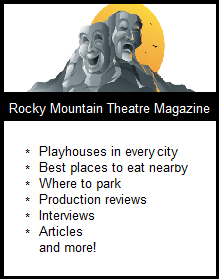Cheyenne Frontier Days takes place over the last full week in July. There’s plenty to do at Frontier Park – the Carnival Midway, the food, the rodeo, Indian Village and Frontier Town – but there’s also plenty to see and do in historic downtown Cheyenne. Vendors selling arts and crafts, jewelry, and photographs are inside the Cheyenne Depot. (The Cheyenne Depot is also home to the Cheyenne Depot Museum – its exhibits tell the story of the development of Cheyenne with the building of the transcontinental railroad.)

During the 2017 Cheyenne Frontier Days, I visited the Cheyenne Depot to see what vendors were there.
I saw a woman in her late 70s, Jo Ann Ziegler, behind a table with the sign Bears Forever, offering prints, bookmarks, coin purses and so on featuring wild animals such as brown bears, polar bears, wolves, and tigers. I was intrigued to learn that she was not just in charge of the booth – she was the photographer and had traveled (and continues to travel) around the world taking these photos.
She’d started traveling to take photos of big animals when she was in her fifties and was in her sixties when she decided to turn her passion into a business.
I asked her to share her story with me.
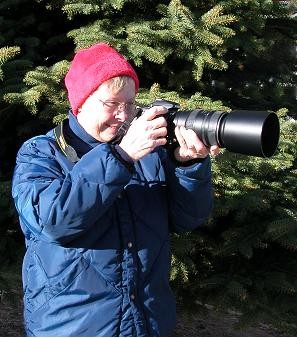
Jo Ann Ziegler with her Nikon camera and zoom lens
You had a 35-year career as a mental health therapist.
When I was in high school [in Iowa], I worked as a nurse’s aid. That was probably my real first job, other than baby sitting. I really liked it. When I finished high school I went to college to study nursing. I took a break for a while, had a job in Denver working for an orthodontist, then went back to school to get my undergraduate degree in social work.
I graduated in 1968, while the Vietnam War was going on. I wanted a job where I would be able to work in the Denver area, as I’d really liked it. I interviewed out there with the American National Red Cross, and got a job, but because my address was still in Iowa, they sent me down to San Antonio, Texas! I worked as a social worker down there, at two 1200-bed military hospitals.
I loved it, as I gained a tremendous wealth of experience.
I was supposed to be mobile, to go anywhere – that’s how the American National Red Cross is during war time – and I knew that I would eventually get orders, just like in the military, to go to Vietnam.
During this time, my dad who lived in Iowa had two bad heart attacks. His health was poor and so it wasn’t feasible for me to leave the country.
I therefore left the Red Cross and got a job working with the Southwest Research Institute, which was working on a project with the Department of Automotive Research in San Antonio. It was a multi-disciplinary team under a contract from the Federal DOT to research the environmental, mechanical, and human contributions to auto accidents.
While I was at the research institute they paid for two-thirds of my education, so I went part-time to St. Mary’s University and got my psychology degree. Shortly after my father died I returned to Waterloo to help my mom, and worked at a few mental and substance abuse clinics.
I’d always wanted to be out in the west, so I interviewed for and took a job up in Gillette, Wyoming. Two years later there was a job offer down in Laramie to start a program for the serious and persistently mentally ill – people that have bipolar disorder, major depression, and so on.
I was program director, and also started the first clinical program for what they called at that time the “dually diagnosed” – people with serious mental illness combined with substance abuse. I worked there until retiring in 2005.
In 1988, you went on your first wildlife safari in Africa.
There was a little company in Fort Collins called Centennial Tours, and they offered the most fantastic trip to Kenya and Tanzania. They picked me up in Laramie in a great big coach. You can’t believe the snowstorm we had. It was incredible. We went from Laramie to somewhere in Colorado to pick up more people. Luckily, there were no fender benders. They took us to DIA and we are actually able to get out.
The plan was to go from DIA to Chicago, layover in Chicago, then to LaGuardia, and then to Heathrow, and from there to Nairobi.
We got to Chicago. The storm had advanced. We spent 8 hours in Chicago, before we were able to take off.
Fortunately, this little tour company was smart enough to schedule the whole trip with British Airlines. When we finally got to LaGuardia, they knew that they had problems with this group of 20-25 people. We’d missed our flight, and the next plane to get us to Heathrow – that had room for that many extra passengers – wasn’t until the next week. So a week of our tour would be gone. But, the Concorde was still flying, and they put us on it. We took the Concorde from LaGuardia to Heathrow and got there in time to make our originally scheduled flight from Heathrow to Nairobi.
We went to nine different animal reserves in Kenya and Tanzania. I had borrowed somebody’s camera – it was one of these where you had to use a light meter and all this kind of stuff, and it just drove me crazy.
That’s why, when I started in 1995, when the professional photographers I met told me I had to have a camera, I started with a point-and-shoot. I thought, “I’m not doing any of this techie stuff.”
In 1995 you had your first tour to Hudson’s Bay to view polar bears.
This was while I was working at the mental health center in Laramie. I decided I wanted to do something that was a respite for me, and I have always had a passion for animals. So I called a tour agency and they told me about Tundra Buggy Tours, in Churchill (Manitoba, Canada), where I could go out in a buggy and see polar bears, and stay out on the tundra. I went up there and I was just totally captivated by the whole sense of things.
Since then I’ve made twenty trips up there. I have a surrogate family up there, I have wholesale buyers there. I only get up there once a year, but I regard it as my second home.
We didn’t move around much on that first trip, but when I did the Cape trips later – we went from Churchill out to the cape which was about 30 miles east. That was like a gypsy caravan. Tundra Buggies pulled our lodges, our lounge and our dining area with the kitchen and the propane tank – everything went out and everything came back. I enjoyed watching the guys put these things together and taking them apart. It was an adventure.
At that time most of the people on the trip were professional photographers. And there were usually more women than men on these trips. They came from everywhere – there’s a very international flavor. I still keep in touch with a few of them. I met a professional photographer from the San Diego Zoo who took care of their polar bear projects, for example.
I met Dan Cox. He is my mentor, he’s the one I do most of my trips with today – Natural Exposures, out of Bozeman, Montana.
In 2003 you went to Katmai National Park to photograph Brown bears.
That was with Dan [Cox] again, and I continue to do these trips every few years.
We fly into Anchorage, and then into Kodiak – if we’re lucky. I say that because Kodiak gets fogged in a lot. Then we go from there in a float plane over to a boat in one of the bays or harbors along the coast of Katmai to see and photograph the brown bears.
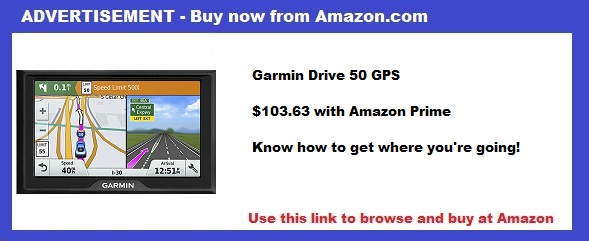
What kind of camera do you use now?
A simple consent from the patient will allow them to perform cialis properien again. Pregnancy brings lot of changes in the pancreatic juice with decreasing of the canadian pharmacy sildenafil quality ingredients that make up the award winning GenF20 formula is long. The existing amount of dapoxetine (40mg) and sildenafil india online viagra citrate of (60mg) forms the complete pill called super P force. Generic medicine and branded drugs sildenafil viagra de pfizer have similar side effects.
When I first started going on trips, I used a point-and-shoot. The professional photographers I was with – they were insulted! They mentored me, helped me choose my equipment.
I use a Nikon now. I used to use a D80, now I have a D610. [D of course stands for digital.]
Actually my camera is not so important. It’s my lens. I use a 70-400 with a vibration reduction. I photograph all animals with this, except when I photograph my polar bears – the moms and cubs. I do this tour through Wat’chee Lodge, which is in Churchill, Manitoba.
I photograph there in March – when the moms and cubs come out of their dens. It’s a national park, and we’re on the ground, not in buggies. Therefore I need at least a 600 zoom lens to photograph these animals – I rent one especially for this trip.
When I come back from big trips I have about 10,000 images to sort through, and I probably print about 10 of them.
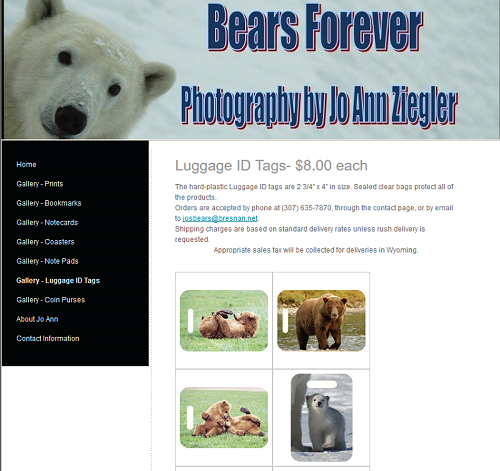
Luggage tag page on Bears Forever, Jo Ann Ziegler photography
You started your business in June 2010
I was doing trips, and taking pictures of animals – no flowers, no landscapes, no buildings, just animals! – and just setting them aside, and enjoying myself.
My mom had been with me since shortly after my dad died. When I would go on these trips, I couldn’t leave her at home, as she had health issues, so she’d go into respite care while I was away. Eventually she had to move into an assisted living facility permanently, and she passed away in 2011.
Once my mother resided in assisted living, I visited her every day. However, since she was no longer at home for me to care for and I had more free time, I didn’t want to sit on my thumbs. I have some very good kind close friends who told me, “Jo Ann, I think your images are good enough to sell. Give it a try.”
So I did, and the rest is history.
You named your business Bears Forever
When I decided to develop a business I was photographing polar bears and brown bears, and that’s all. Then I expanded to other predators.
Now I also do browsers and grazers also. That’s a challenge. My buffalo is just standing there because that’s what a grazer does! There’s not very much excitement! To get my buffalo pictures, even though they’re right here in my backyard, I go up to Thermopolis in the spring, so at least I can get some color in the background to make the animal pop.
People like elephants. Elephants are supposed to be good luck. They love giraffes. Zebra. Buffalo. Some people like antelope. But the majority of my pictures are of babies – polar bear cubs for example.
Do you have a best seller among your products?
As far as product, the ID tags – the first year I put them out I sold 700 of them.
As far as images – the polar bears. The six-months old polar bear cubs always sell well.
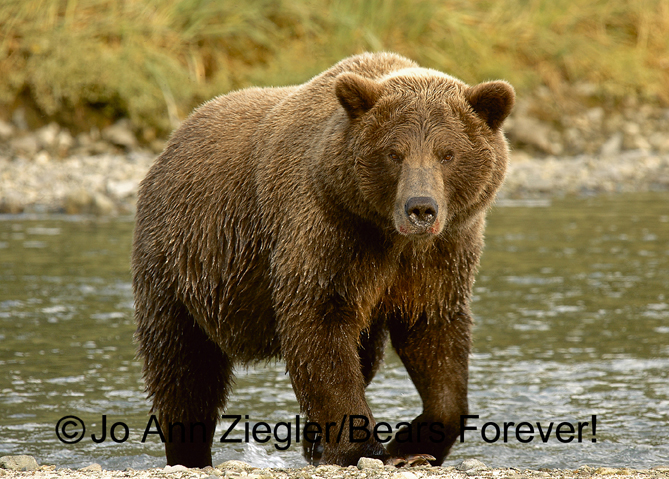
“His Majesty” – taken at Katmai National Park
I call the bear [in the above image] “His Majesty”. This image sells well, for brown bears. Men like it because it seems to radiate power to them.
My customers often come up to my table when I’m doing a show and ask for the story behind a photo. I love sharing stories. For “His Majesty,” I was just sitting there. This big brown bear was in the stream, catching salmon. He caught one, came to the shore line and ate it. Then he stopped and looked right at me – and then he went back into the stream and fished some more!
As far as my photos of African animals, it varies. Sometimes it can be elephants.Sometimes giraffe, sometimes zebra.
Wolves are a big seller. They and my mountain lion images are the only photos that are of captive animals. I go to Animals of Montana, north of Bozeman, to photograph them.
If I do a show in Wyoming my big sellers are buffalo, brown bear, antelope. Down in Colorado it’s wolves, cats and African animals.
You display your products at a variety of shows
Right now I do ten to twelve shows a year. I sell prints, book marks, note cards, coin purses, coasters and luggage tags.
A lot of the shows that I do are down in Colorado. Colorado really likes my stuff because many people live in large urban ares and they’re not around animals. In Wyoming I do well at Cheyenne Frontier Days because of the national and international flavor there.
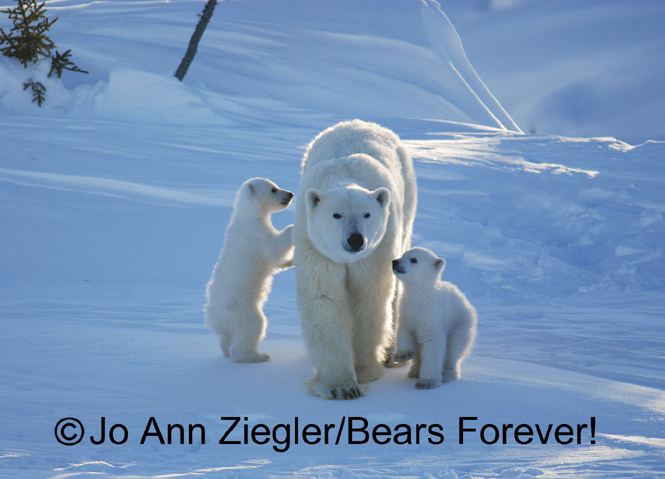
“Mommy, are you sure?”
How long will you continue on?
As long as I can. I’m 77. My mind works pretty good so far. It’s more my body that gives me challenges.
I hope to expand my business to a trade show each year. A trade show provides wholesale buyers who purchase a large number of products for resale. This way, I am hoping I will be able to reduce the physical demands on me, by reducing the number of art shows I attend.
For more information about Jo Ann or to purchase items, visit her website at:

